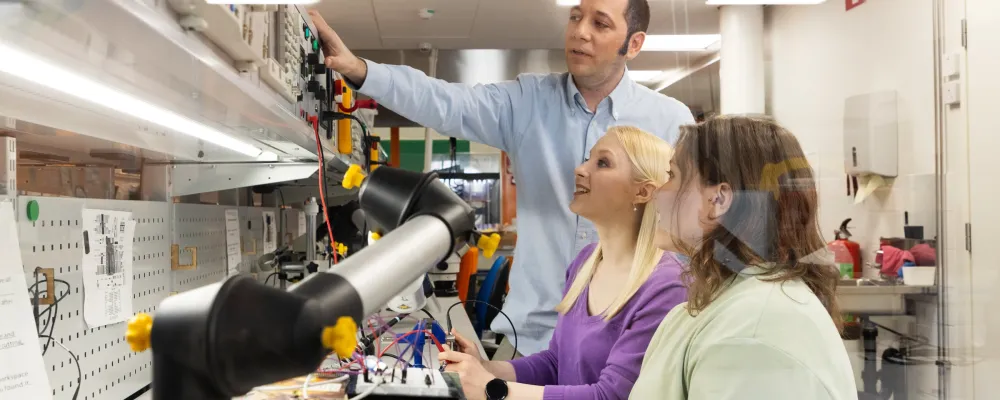This study examines ways to boost female representation in fields of technology at universities. TEK aims to promote a more equal gender balance in the field. This would bring many benefits not only to universities, but also the labour market and society.
Key recommendations
Bold rebranding of degree programmes
The choice of field of study and study track is motivated as much by impressions as by rationality. What value proposition does the name and content of the degree programme offer? Do they successfully reflect the key role of the field in addressing major societal challenges and saving the world? In this study, we highlight several inspiring cases of successful rebranding.Enjoying the world’s best student culture
The student culture in the field of technology has transformed in recent years. Students have taken a giant leap towards a more inclusive student culture. This is something that should be communicated to young people considering the field, and the best possible partners for communicating this are the students themselves. It is worth making more systematic use of students’ skills and developing an even better study and student culture in cooperation between students and the university.Cooperation and pooling resources
All key players in the field of technology try to do their part in balancing the gender ratio in the field. In addition to this common ambition, there is a relatively unified view on the measures required. This starting point provides an excellent basis for extensive marketing and branding campaigns, as long as the partners can join forces and channel small streams of resources into one great current.
Background
In recent years, the proportion of female students in university education in the field of technology has developed in a positive direction. From 2018 to 2024, the change has been dramatic, with an increase of around 8 percentage points in both engineering, manufacturing and construction (EMC) and information and communication technologies (ICT)[1]. In the same period, the share of women among primary applicants in these fields has increased by just under 3 percentage points. Among the bigger fields of education, the largest increase in the share of women among students and new students has been in the field of Chemical engineering and processes, which includes degree programmes in Chemical Engineering, Biotechnology and Process Engineering (Vipunen 2025). We believe that this positive development can be continued and accelerated further by developing the study options, course content, marketing and culture in the field of technology. This study presents good practices from universities in the field of technology that we hope will also spread elsewhere.
A more equal gender balance in technology would bring significant benefits. Universities would benefit as an increase in female applicants would broaden the pool of applicants and allow for the selection of even more proficient students. Universities would also benefit from the higher academic performance of female students, as universities are rewarded financially for study progress and graduating students. Society and the economy would benefit from a more diverse technology sector, as diversity in workplaces promotes innovation and the quality of innovations. In addition, the pool of potential applicants is increasingly female: 59% of new upper secondary school students in 2021 were female and 41% male. Similarly, 59% of all new university undergraduates this year were women.
[1] Information and Communication Technologies (ICT) also includes BSc, Computer Science, and MSc, Computer Science students, with the exception of the University of Helsinki

This study was inspired by the newly established degree programme in Energy Transition at Tampere University. How has a degree programme that focuses on male-dominated electrical engineering and that includes male-dominated studies in automation, civil engineering and energy technology been so much more successful in attracting female students than the degree programmes that make up the Energy Transition programme? This weak signal raised the question of whether, with the right formulation of names and descriptions of degree programmes, it would be possible to attract significantly more female students to study technology, as has been the aim for several decades.
The study is based on a survey sent to all universities of technology to learn more about their interventions to attract female students to the field. In addition, several background discussions with individual fields of technology and study options have been held for the study and TEK’s prior research and expertise has been utilised. The report presents the results of the survey and provides recommendations for interventions to improve the attractiveness of the field of technology.
In attracting female students to the field, it is important to keep in mind the systemic level and not to resort to sub-optimisation: we do not want to see separate male- and female-dominated fields within technology, but a more equal gender balance across all study options.
Results of the survey
The purpose of the study was to gather information about the measures taken by universities to attract female students, for example in terms of marketing, renaming degree programmes and updating course content. Data was collected through a concise questionnaire sent to all universities offering education in technology. The questionnaire was open from 4 November to 22 November 2024.
We received 23 responses. The majority of respondents answered from the perspective of more than one study or degree programme and a few respondents from the perspective of the whole university. Responses were received from almost all universities of technology. The proportion of women in the degree programmes mentioned by the respondents varied from around 5% to 80%.
The questionnaire asked about any measures that had been taken to attract female students from the perspective of five different themes. The themes were
cooperation with other higher education institutions,
cooperation with schools, associations or other organisations,
marketing specifically to female applicants,
changing the content or names of degree programmes to make them more attractive to female applicants, and
other special measures and strategies.
If the respondent stated that the institution they represent had taken measures in line with one of the themes, they were asked to specify and describe the actions in more detail in an open field.
The questionnaire highlighted the various actions taken by degree programmes and universities to attract female students to the field. By far the most respondents mentioned marketing to female applicants. The least frequent measure was changing the content or names of degree programmes (Figure 1). Some respondents already represented a female-dominated degree programme, in which case measures aimed specifically at attracting females were not seen as particularly relevant. Nevertheless, these programmes had still taken some measures, such as participating in the Shaking up Tech event.
Two respondents indicated that the degree programmes they represent had not taken any measures in line with the themes in the questionnaire to attract female students to the field, despite the fact that these respondents represented highly male-dominated fields of technology.

The measures identified in the questionnaire are presented in more detail below. The responses are themed under different headings than in the questionnaire itself, as different respondents described similar actions under different headings.
Key findings from other studies
Both the TEK Graduate Survey and Student Survey (Figure 2 and Table 2) have found differences between male and female students that are interesting in light of this survey. For example, women systematically consider sustainability skills as a more important career skill than men.


According to a study by Junior Achievement (JA) Finland, there are interesting gender differences in young people’s career values and their views of the most important career skills (Figures 3 and 4). The differences in career values are smaller, but girls are more likely than boys to, for example, express a willingness to help others through their work and show concern for the environment. As for the most important career skills, differences are particularly obvious in the appreciation of the ability to face and respect diversity, and of emotional skills. In general, the results suggest that girls find so-called soft values and skills more important than boys and vice versa.


Conclusions
The problem in the field of technology is not that women are not interested in its contents, but that they seem uninteresting to women. This view is also supported by the observation that many of the women who initially start studying technology with the intention of applying to another programme later end up staying in the field. Rather than changing the content, the most important thing would be to change the perceptions associated with different fields of technology. All degrees in technology open up a wide range of career paths, but the image of a career in technology can be very narrow.
When attracting women to technology, it would also be good to work in cooperation with the UAS sector, as it is becoming increasingly common to pursue a master's degree in technology as a UAS degree. If the current gender imbalance in fields of technology at universities of applied sciences remains, it will be difficult to achieve equal gender representation, even if progress continues well at universities.
While attracting more female students to the field of technology, efforts must also be made to develop the working culture in technology. It will be difficult to convince female applicants that they can look forward to a rewarding career if the unexplained pay gap persists, discrimination and harassment continue, and women have fewer opportunities to progress in their careers.


